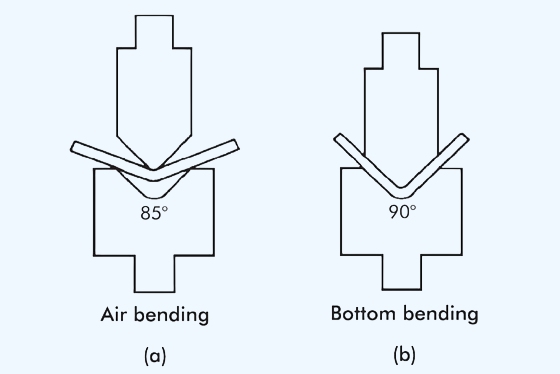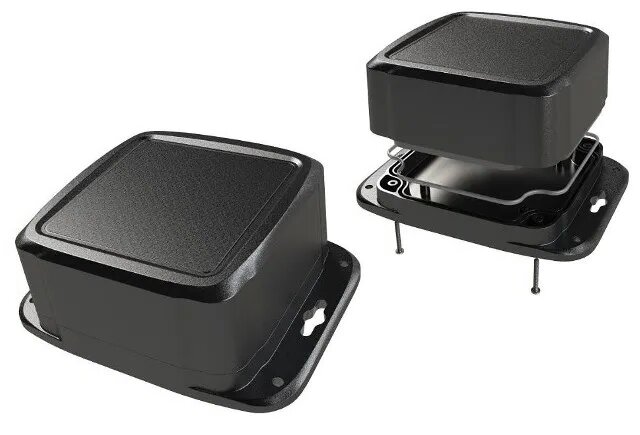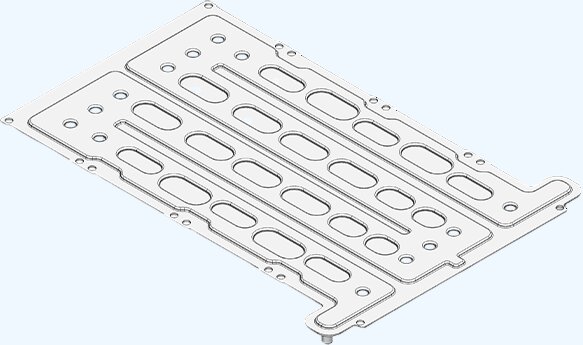今日のエレクトロニクスは、かつてないほど速く、小さく、接近して動作しています。このような高密度化により、電磁干渉の影響を受けやすくなり、静かに性能を乱したり、システム障害を引き起こしたりする可能性があります。
すべての回路は電磁エネルギーを放出し、受信します。制御されていない場合、これらの信号は筐体を通して漏れ、近くの部品に結合します。これが電磁干渉(EMI)であり、より高い周波数では無線周波干渉(RFI)になります。
自動車、航空宇宙、通信システムでは、わずかな干渉でも測定値がずれたり、プロセッサがリセットされたりすることがある。あるテストでは、1mmの継ぎ目の隙間が制御ユニットのシールドを30dB低下させ、動作が不安定になるのに十分でした。これが、最新の設計チームがEMI/RFI保護を後付けではなく、構造要件として扱う理由です。
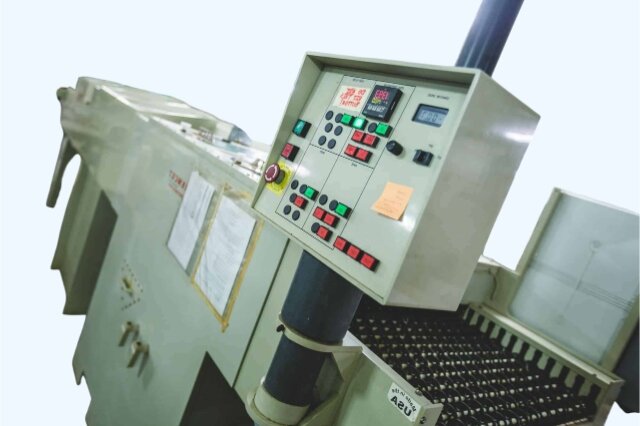
EMIとRFIの原因は?
干渉はデバイスの内部から来ることもあれば、周囲の環境から来ることもある。安定したパフォーマンスのためには、どちらの経路も制御が必要です。
- 内部情報源 スイッチング電源、マイクロプロセッサー、高速デジタル回線。
- 外部ソース 不要なエネルギーを注入するアンテナ、モーター、無線送信機。
シールドされていない場合、これらの信号はクロストーク、データエラー、あるいは通信の完全な損失を引き起こします。自動車ではEMIが安全センサーを妨害し、病院ではRFIが医療測定値を歪める可能性がある。シールドの目的は単純で、エミッションの放出を止め、外界の侵入を防ぐことです。
シールドの仕組み
適切なシールドは、3つの物理的メカニズムによって電子機器を保護する。これらが相まって、実際の効果が決定される。
- 反省: 導電性の金属表面は電磁波を反射する。
- 吸収: 金属の磁気的、抵抗的特性により、エネルギーは熱として放散される。
- アースの導通: 残った電荷は安全にグランドに流れ、クリーンな内部信号を維持する。
シールド効果は、しばしばデシベル(dB)で表されます。20dBの低減は90%の干渉エネルギーカットに相当します。60dBのバリアは99.9%を遮断します。
材料の導電率、透磁率、厚さはすべてこの数値に影響します。例えば、銅製シールドは1GHzで100dBの減衰に達することがありますが、薄いアルミ製ハウジングは通常80~90dBです。
エンクロージャー設計の役割
強力な素材だけでは不十分で、形状と組み立てがシールドの成功を左右する。
小さな開口部もアンテナのように機能する。0.5mmという小さな継ぎ目でも、密閉されていないと高周波エネルギーが漏れることが実験で示されています。そのためエンジニアは、最適な性能を確保するために、フランジの重なり、継ぎ目の折り返し、連続的な接触経路を設計しています。
効果的なエンクロージャーは、すべての側面に導電性の回路を維持する。
そのためには
- シームコントロール: オーバーラップまたは導電性ガスケットを使用してパスを閉じる。
- 一貫したコンタクト: 接合面に塗装や酸化がないようにする。
- 接地: 浮遊電圧を避けるため、すべてのパネルを単一の接地点に接続する。
CADモデルからこのような実践を始めると、製造と組み立てがより予測しやすくなります。早期に遮蔽設計を行うことで、コンプライアンス結果を改善し、後工程の手戻りを50%以上削減することができる。
EMI/RFIシールド・エンクロージャーの材料と製造
エンクロージャが電磁波をいかに効果的に反射または吸収するかは、材料の選択によって決まります。導電性、強度、耐腐食性、長期的なコスト安定性のバランスが取れたものが最適です。
適切な材料の選択
銅は比類のない導電性を提供し、アルミニウムは優れたシールド性と軽量性を兼ね備えています。ステンレス鋼は腐食に強く、構造荷重に耐えるが、抵抗率が高い。
以下は、多くの製造プロジェクトで使用される簡略化した比較である:
| 素材 | 伝導率 | 透磁率 | 耐腐食性 | 典型的な使用例 |
|---|---|---|---|---|
| 銅 | 素晴らしい | 低い | 適度 | 高周波エンクロージャ、RFコネクタ |
| アルミニウム | 非常に良い | 低い | 高い | 軽量筐体、電気通信、アビオニクスボックス |
| ステンレス・スチール | 適度 | 高い | 素晴らしい | 過酷な環境、構造ハウジング |
| ニッケルシルバー | グッド | 適度 | 高い | 機能的なシールドを備えた装飾的なハウジング |
| ミューメタル | 低い | 非常に高い | 適度 | 低周波磁気シールド |
実際の条件下では、銅筐体は1GHzで最大100dBの減衰を達成できます。アルミ筐体は85-90dB程度で、ステンレススチールはその磁気特性により低周波数で最高の性能を発揮します。
コスト面では、アルミニウムは銅よりも30~40 %安く、機械加工も容易です。コスト、導電性、耐食性のバランスがとれているのです。
材料を周波数範囲と環境に適合させる
遮蔽性能は、干渉の種類と使用環境の両方に依存する。エンジニアは、材料の物理的性質をアプリケーションのニーズに合わせる必要があります。
低周波(10MHz以下)では、透磁率が最も重要で、スチールとミューメタルが磁気エネルギーを効果的に吸収する。高周波数(10MHz以上)では、電気伝導率が支配的で、銅とアルミニウムが波エネルギーのほとんどを反射する。
環境条件がその選択をさらに洗練させる:
- 屋外または船舶用システム: アルミニウムまたはステンレス鋼に不動態化処理または陽極酸化処理。
- 医療機器または検査機器 ニッケルメッキを施したスチール製で、表面を汚さず清潔。
- 自動車または産業用制御機器 湿気に強く、表面の導電性を維持する亜鉛または錫メッキ鋼。
早期に適切なコーティングや仕上げを選択することで、接触抵抗を上げ、長期的なシールドを20dBも弱める酸化を防ぐことができる。
シールド板金部品の製造方法
製造方法は、選択した材料が意図したとおりの性能を発揮するかどうかを決定する。精度、一貫性、再現性のすべてが、実際の遮蔽結果に貢献します。
レーザー切断とCNCパンチング
カスタム形状、ベントパターン、試作エンクロージャーに最適。 レーザーカット エッジは、ガスケット接触部を清浄に保ち、リーク経路を減少させます。少量生産から中量生産、または設計が変更される可能性がある場合に最適です。
スタンピングと深絞り
生産量が数千個を超える場合、 足踏み が費用対効果の高い選択肢となる。金型投資額は高くなるが、一度セットすれば、部品は非常に安定している。 深い描画 は、溶接の継ぎ目をなくし、機械的強度とシールド性能を最大10dB向上させたシームレス・ハウジングを製造している。
光化学エッチング
厚さ0.2mm以下の薄くて細かいEMIシールドやガスケットフレームに使用。このプロセスでは機械的ストレスが発生しないため、繊細なパターンでも寸法精度が維持されます。エンジニアは、新たな金型を必要とせず、迅速な設計の反復を必要とする小型の電子シールドにエッチングを選択することが多い。
エキスパンドメタル箔とメッシュ
エキスパンドフォイルは、通気パネルや曲面に軽量で柔軟なシールドを提供します。良好な電気的導通とオープンエアフローを兼ね備えており、航空宇宙や高密度エンクロージャーに最適です。一部の設計では、箔層をサンドイッチ構造または熱パネルに直接統合し、二重目的で使用します。
溶接、接合、導電性
よくできたシールドは、すべての接合部にわたって信頼できる電気的接触があるかどうかにかかっています。接合方法は、抵抗、耐久性、EMI安定性に直接影響します。
- スポット溶接またはシーム溶接: 金属と金属の連続的な結合を保証します。
- 導電性ガスケットまたはフィンガーストック: リムーバブル・パネルの接触を維持する。
- 組み立て前の表面クリーニング は、耐性を高める酸化物やコーティングを除去する。
ボルトジョイントの場合、設計者はしばしばファスナーの下に鋸歯状ワッシャーやニッケルメッキを指定します。適切に処理された継ぎ目は、接合抵抗を2ミリオーム以下に維持し、電圧差を防ぎ、エンクロージャの寿命を通じて一貫した減衰を保証します。
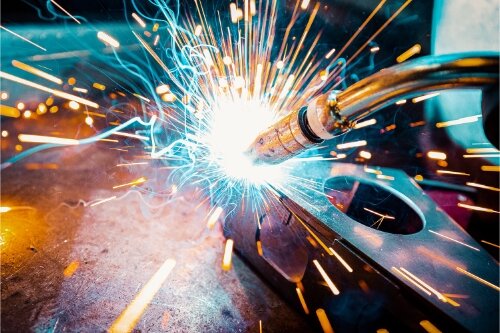
効果的なEMI/RFIシールドのための設計上の考慮事項
最も費用対効果の高いEMI対策は、製造が始まるずっと前から始まっています。早期の設計計画により、電気的ギャップを防ぎ、アセンブリを簡素化し、コンプライアンス・テストの結果を改善します。
設計の早い段階でのシールドの統合
CADモデルにシールドを組み込めば、エンジニアは折り目、継ぎ目、接触ゾーンを整列させ、クリーンな導電性を得ることができます。例えば、オーバーラップフランジや連続ベンドは、バットジョイントよりもフィールドリークを遮断します。テストによると、単純なオーバーラップ設計では、フラットシームと比較して15~25dB減衰が改善されます。
このアプローチは、余分な工具を使用せずに精度を維持することにも役立ちます。接合形状を早期に定義することで、チームは後期の手戻りを回避することができ、その結果、リードタイムとコストを最大30%削減できるプロジェクトもあります。
開口部、開口部、換気の管理
開口部は避けられないが、すべての穴はシールドを弱める。適切な通気孔と開口部の設計は、電磁波漏洩の経路を作ることなく空気の流れを可能にする。
ホールの有効性は、入射光の波長に対するホールの大きさに依存する。信頼できるルールは、直径をターゲット周波数の波長の20分の1より小さくすることである。1GHz(波長≒300mm)では、15mm以下の穴でも強固な遮蔽を保つことができる。
機能と保護を両立させるために、エンジニアはこうしている:
- ハニカムベンチレーション: 高周波を遮断する導電性の薄い細胞。
- 導電性メッシュまたは穴あきシート: 冷却気流との電気的導通を保つ。
- ガスケット付きベントカバー: 取り外し可能な部分をシールすることで、安定した接触圧を実現。
精密なレーザー切断と組み合わせることで、これらの機能は製品のライフサイクルを通じて形状と電気的完全性の両方を維持します。
接地と継ぎ目の連続性
シールドは、その電気的な経路と同じだけ優れています。適切な接地は、パネルのアセンブリを、不要なエネルギーを放散する単一の導電性エンクロージャーに変えます。
良好な接地設計には以下が含まれる:
- ベアメタル接触ゾーン ファスナーの下、またはパネルとパネルの間。
- 導電性コーティング接合面には、ニッケルめっきやスズめっきなどが使用される。
- ボンディングストラップまたはスタッド 絶縁されたパネルを共通のグランドに接続する。
テストでは、接触抵抗が2mΩ以下の接合部は、何千回もの組み立てサイクルにわたって安定した遮蔽を実現しています。わずかな酸化でも抵抗は2倍になるため、設計エンジニアは保護しながらも導電性の仕上げを指定することがよくあります。
表面仕上げと導電性コーティング
適切な仕上げは、導電性を犠牲にすることなくエンクロージャーを保護します。非導電性コーティングはパネルを孤立させ、性能を低下させる可能性があるため、このステップは非常に重要です。
導電性めっきオプション:
- 錫メッキ - はんだ付けが容易で、耐食性に優れている。
- ニッケルめっき - 屋外や産業用として耐久性がある。
- 亜鉛-ニッケル合金 - コスト効率に優れ、スチール製ハウジングに適合。
外観または腐食防止用、 粉体塗装 を選択的に使用することができる。エンジニアは接地パッドをマスキングしたり、導電性インサートを追加してコンタクトゾーンを維持する。特に金属とプラスチックのハイブリッド・アセンブリでは、耐久性とEMI性能を両立させるためにカーボン充填塗料や銀系塗料を使用する筐体もあります。
組み立てとメンテナンス設計
シールドは、取り扱い、組み立て、長期間の使用を通じて信頼性を維持しなければならない。よく設計されたジョイントとファスナーは、振動、腐食、繰り返しのアクセスによる劣化を防ぎます。
主な設計手法は以下の通り:
- ベリリウム銅フィンガーストック ハイサイクル・ドアおよびカバー用。
- ロック式ステンレス製ファスナー トルクを維持し、緩みを最小限に抑える。
- 安定した締め付けトルク パネルの反りや空隙が生じないようにする。
工場データでは、一貫したファスナートルクは、ユニット間で最大10 dBのシールド再現性を向上させることができます。このようなシンプルなディテールが、最終的なアセンブリが紙の上だけでなく、設計通りに機能することを保証します。
EMI/RFIシールドの実際の用途
様々な産業における高周波電子機器は、安定性とコンプライアンスを維持するために、優れた設計の板金筐体に依存しています。ここでは、実際のシールドの様子をご紹介します。
電子・電気通信
高速通信機器は、途切れることのないシグナルインテグリティを要求します。シールドされたシートメタルハウジングは、絶え間ない電磁波の存在下でも、繊細なコンポーネントの安定性を維持します。
ルーター、IoTゲートウェイ、制御モジュールは、アルミニウムまたは銅製の筐体を利用し、近隣の送信機からの干渉を遮蔽します。レーザーカットされた通気孔とガスケットされた継ぎ目は、連続性を維持しながら冷却を可能にします。あるテレコムのケースでは、シームの重なりを改善することでエミッションが35 %減少し、設計を変更することなく完全なEMC認証を取得することができました。
5Gネットワークとデータセンターが拡大するにつれ、これらの設計管理はクロストークを防ぎ、スループットを保護し、目に見えない干渉によるダウンタイムを削減するのに役立つ。
自動車・運輸
自動車には何十もの制御ユニット、センサー、高電圧システムが組み合わされており、そのすべてが電磁界を放射しています。適切なシールドは、信頼性の高い通信と安定した安全システムを保証します。
バッテリー管理システム、レーダー・センサ、モーター・コントローラは、電磁界を閉じ込めるために精密な曲げ加工を施したハウジングを使用している。導電性、耐腐食性、コスト効率を兼ね備えているため、アルミニウムや亜鉛メッキ鋼が一般的に使用されている。
何百万回もの振動サイクルでも低い接触抵抗を維持するために、シーム溶接や錫メッキが施されることがよくあります。製造テストでは、ステンレススチールまたは亜鉛メッキスチールのカバーは、長期の熱サイクル後も95%以上のシールド性能を維持しました。
航空宇宙・防衛
航空宇宙システムには、高度、振動、極端な温度条件に耐える軽量で高性能なシールドが必要です。1グラム1グラムが重要であるため、材料とプロセスの選択は非常に重要です。
アルミニウム合金とエキスパンドメタルフォイルにより、最小限の重量で強力なEMI保護を実現。ハニカム構造のベントパネルは、高周波帯域で60dB以上の減衰レベルを維持しながら、空気の流れを可能にします。
精密成形により、パネルの完璧なアライメントと接地の連続性が保証されます。各エンクロージャーは、最終組み立ての前に導電性と抵抗の検証を受けますが、これは過酷な飛行条件下での長期的な信頼性を保証するものです。
医療機器および産業機器
病院や工場は電磁ノイズに満ちています。機密性の高いシステムで信号の歪みや誤った読み取りを防ぐには、シールドが不可欠です。
医療用画像処理装置、モニター、実験用分析装置は、衛生面とシールド性能の両方から、ニッケルメッキやステンレススチール製の筐体を使用することが多い。ある病院では、連続接地キャビネットにアップグレードすることで、動作中の干渉スパイクが70 %減少しました。
産業用制御盤は振動、湿度、高荷重にさらされます。ステンレス製または粉体塗装のアルミニウム製エンクロージャは、構造的強度と安定した電気的導通を兼ね備えており、厳しい環境下でも長寿命を保証します。
結論
効果的なEMI/RFIシールドとは、単に金属ボックスの中に電子機器を入れることではありません。
カスタム板金加工は、信号を保護し、熱を管理し、正確な機械的公差を満たすエンクロージャを可能にします。このような設計を最初から計画することで、テストの失敗を減らし、製造コストを削減し、長期的な信頼性を高めることができます。
シールドシートメタルエンクロージャの設計や製作にお困りですか?当社のエンジニアリングチームは、EMI/RFIに敏感なコンポーネントのDFMレビュー、材料推奨、ラピッドプロトタイピングを無料で提供しています。 今すぐCADファイルをアップロードあなたのデザインを生産可能な状態にする最も効率的な方法を見つけるお手伝いをいたします。
よくあるご質問
EMIシールドとRFIシールドの違いは何ですか?
EMIはすべての電磁波障害を含むが、RFIは電磁スペクトルの高周波数範囲を指す。
どの金属が最も遮蔽性が高いか?
銅とアルミニウムは高周波の干渉に最適で、スチールやミューメタルは低周波の磁場をより効果的に扱う。
粉体塗装のエンクロージャーはシールドとして機能しますか?
接触部が導電性のままであれば可能。接地パッドまたはマスキングゾーンが表面の導通を維持する。
遮蔽効果はどのように測定するのですか?
通常、異なる周波数帯域で標準化された減衰テストを行い、デシベル(dB)単位で測定されます。
EMI/RFIシールドが最も重要な産業は?
電気通信、自動車、航空宇宙、医療、産業オートメーションはすべて、性能と安全のために強力なシールドに依存しています。

ケビン・リー
レーザー切断、曲げ加工、溶接、表面処理技術を専門とし、板金加工において10年以上の実務経験があります。シェンゲンのテクニカルディレクターとして、複雑な製造上の課題を解決し、各プロジェクトにおける革新と品質の向上に尽力しています。

